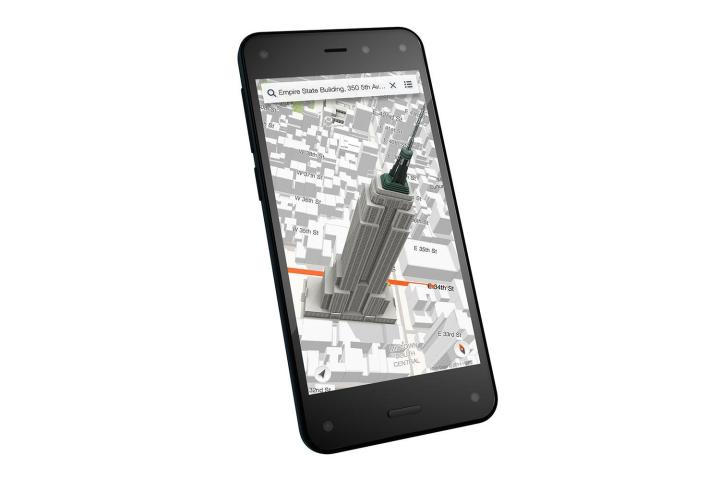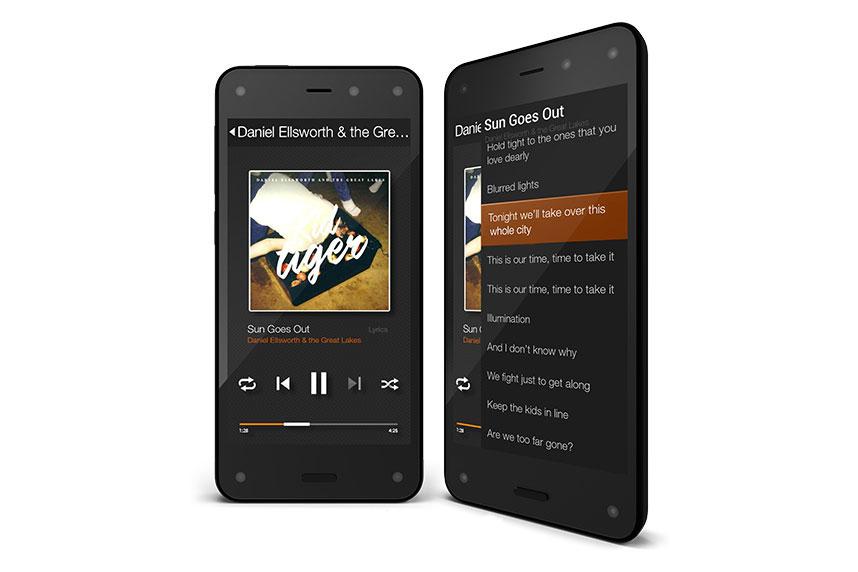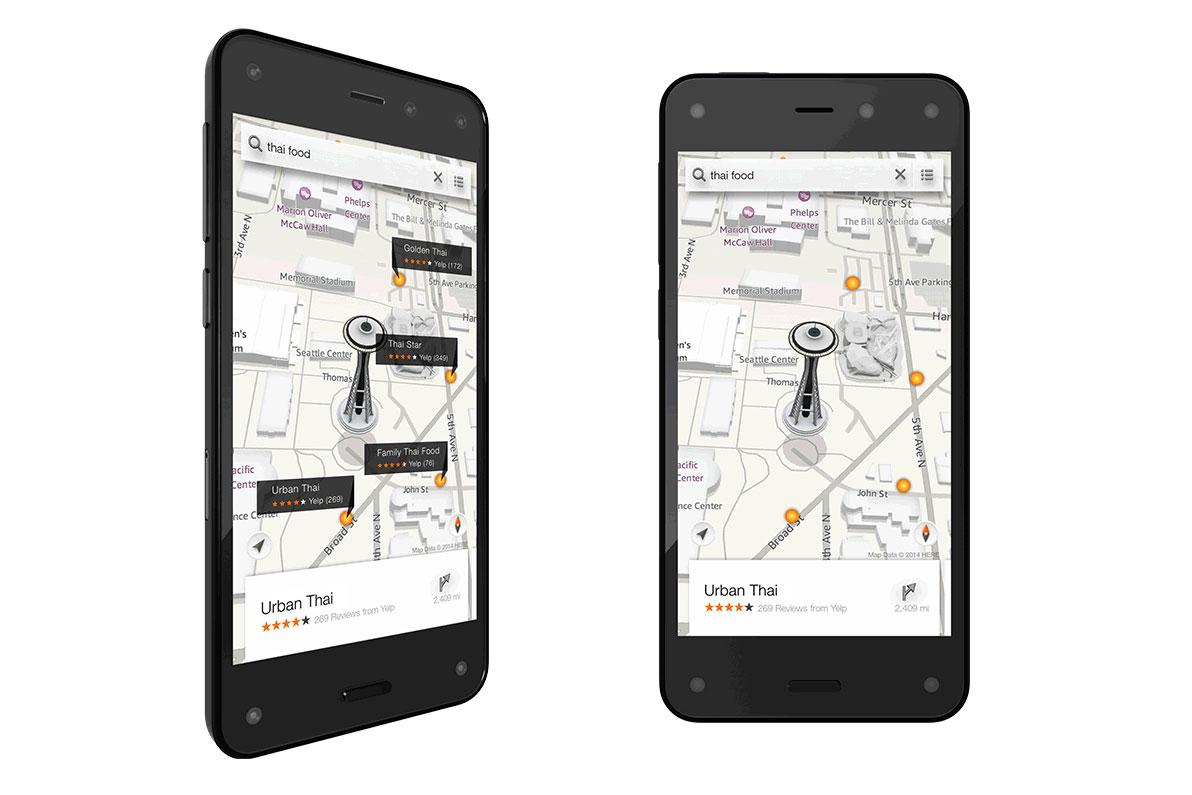
After years of waiting, Amazon finally unveiled its smartphone, the Fire Phone, on Wednesday. As we expected, Amazon is doing things a little differently than the generations of 3D phones that have come before.
Don’t call it 3D. Call it Dynamic Perspective
During the event, Amazon CEO Jeff Bezos referred to its technology not as 3D, but as “Dynamic Perspective.” It’s a fundamentally different effect from what we’ve seen previous 3D phones produce, like the HTC EVO 3D. Objects on the screen will subtly shift as you move your head, as if they existed at different depths within the phone, but they won’t appear to poke out at you, or have real depth at rest. Holding the screen and your head completely still, there would appear to be no 3D effect at all; the illusion is only generated by shifting perspectives.
Think of it like the 3D chalk paintings you sometimes see that depict what looks like some sort of hole in the Earth. It might make a good photo op to pretend you’re teetering on the edge of a chasm, but in person, you wouldn’t look down and get vertigo, because your eyes give your brain the depth information to know the image you’re looking at is only four feet away.

The Fire Phone uses four front-facing cameras to track the movement of your head and “redraw” the image on the phone’s screen from your new vantage point. According to Bezos, Amazon was working on the technology for four years, with the CEO noting that one camera wasn’t enough to deliver the dynamic perspectives due to the narrow field of view. By placing four cameras instead of just one, it can continually track your head while delivering a wider field of view.
Using four cameras has other perks, too. The Fire Phone will use the best two cameras in the event that the other two end up covered by thumbs. And in the dark, each camera has infrared lights to continue keeping tabs on you.
Tilt, swivel, and peek
Besides just looking cool, Dynamic Perspectives can be useful, too. By tilting the handset, you can change the point of view you have of a landmark in the maps application, for example. You can also tilt the handset to learn about any Yelp reviews nearby restaurants have, and look through various products while shopping.
More specifically, tilting the Fire Phone from right to left brings up a panel that lets you access various information. For example, if you tilt while in the Amazon Music application, it will bring up the right panel that shows the lyrics of the song you’re currently listening to. The left panel, meanwhile, lets you navigate through menus.
By swiveling the device, you can access notifications and quick settings, such as MayDay, the flashlight, airplane mode, and more. Swivel and tilt also work if you want to scroll up and down a webpage, for example, or when you want to go to the next page while reading a book in the Kindle application.
Where does the technology come from?
TechCrunch claims that it knows where Amazon is getting its Dynamic Perspective technology. The site’s sources say that Japanese company Omron Okao Vision is responsible for the Amazon smartphone’s unique Dynamic Perspective effect. Amazon reportedly altered Okao Vision’s facial recognition and tracking technology to suit its purposes. The original Okao tech allows for analysis of the user’s face to determine age, ethnicity, and gender. Since Amazon only showed off the Fire Phone’s head-tracking capabilities, we assume that analysis won’t be included.
The Okao technology reportedly uses coordinates from the four cameras on the front of the phone to recognize the user’s face. The phone’s built-in gyro sensor and accelerometer help make Okao work faster and more efficiently.
Revolutionary tech or gimmick?
From what we know about the Amazon phone’s specs, it looks like the Dynamic Perspective and special gestures are the only things that will differentiate this smartphone from all the other ones that are already out there. Amazon will surely promote these effects as original and ground-breaking, but in reality the phone’s 3D powers might just be a flashy gimmick. After all, based on these reports, it’s not like the cameras and the sensors actually do anything spectacularly different from what other devices already do. Sure, it will look cool, but it’s not exactly Project Tango.
Even so, to say that the Fire Phone utilizes 3D technology to its advantage would be belying what the Fire Phone is capable of. While both of LG’s 3D smartphones failed miserably and simply irritated users and the HTC EVO 3D didn’t fare much better, they attempted to cash in on a trend. Amazon seems to take the concept of 3D and take it to various levels above gimmick. Much like the handset itself, however, Dynamic Perspective will live or die by whether developers incorporate the feature into their apps and whether people will care enough to use it on a regular basis.
Editors' Recommendations
- The iPhone’s futuristic satellite tech isn’t coming to Android any time soon
- The Galaxy Z Fold 3 isn’t better than the Oppo Find N, and that’s a good thing
- Qualcomm’s long-awaited second-gen 3D Sonic fingerprint sensor is 50% faster
- Facebook 3D Photos no longer requires Portrait mode on dual-camera phones
- The Qualcomm 3D Sonic Max fingerprint sensor lets you scan two fingers at once




